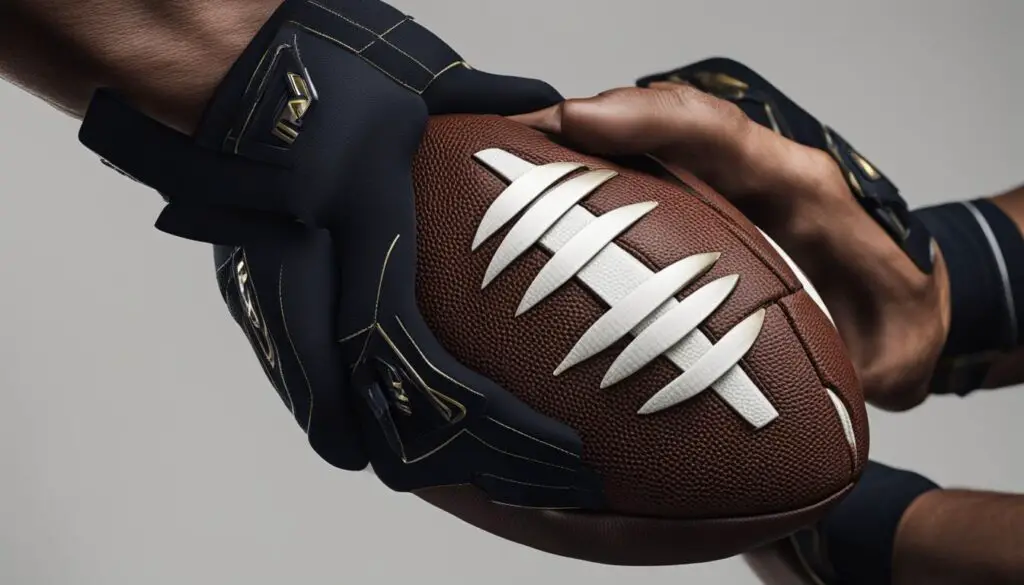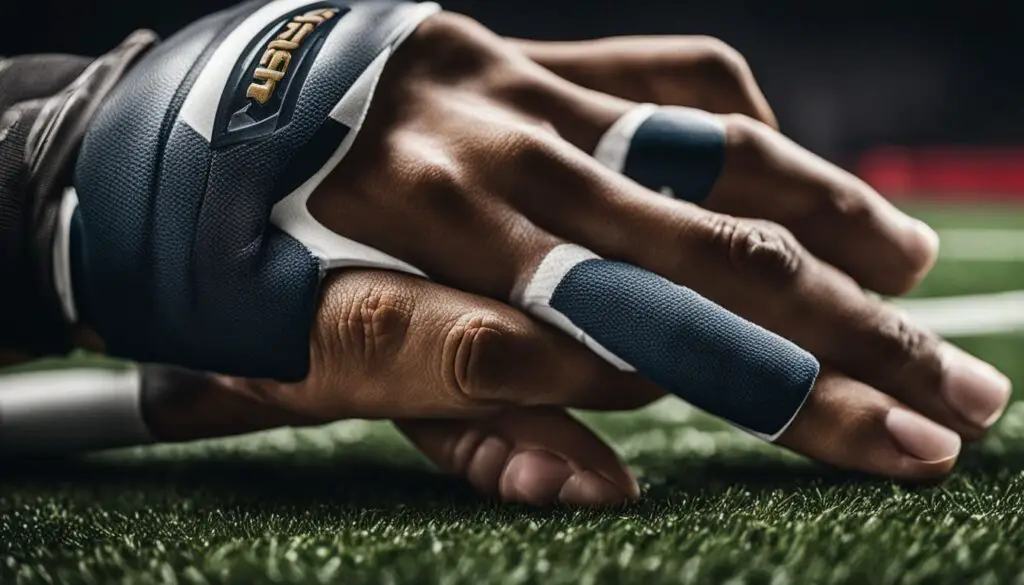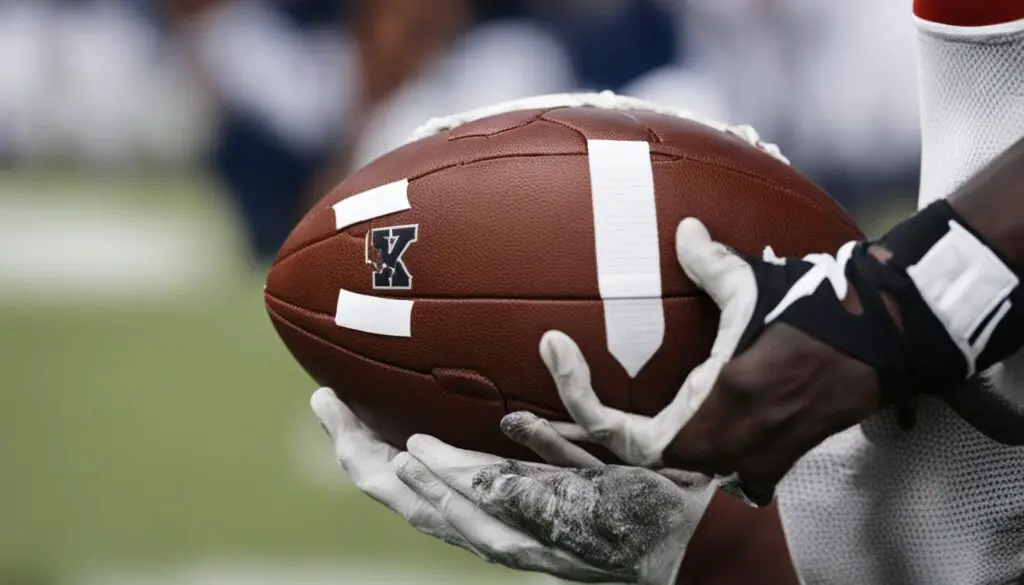Football players often tape their fingers for a variety of reasons. This practice provides additional support and stability to the joints, reducing the risk of injuries such as sprains, dislocations, and breaks. Not only does taping limit the range of motion, but it also helps prevent hyperextension, which is particularly beneficial for linemen and wide receivers who face intense physical contact.
Key Takeaways:
- Taping fingers in football offers additional support and stability to prevent injuries.
- Linemen and wide receivers benefit the most from finger taping due to the nature of their positions.
- Proper finger taping techniques and the use of adhesive, non-stretch sports tape are recommended.
- Taping can aid in injury recovery and allow players to return to the game sooner.
- Finger taping does not improve grip strength, according to a study in the American Journal of Sports Medicine.
Benefits of Finger Taping in Football
In the high-intensity sport of football, finger taping plays a crucial role in preventing finger injuries and keeping players on the field. The importance of finger taping cannot be overstated, as it provides additional support and stability to the joints, significantly reducing the risk of injury. By limiting the range of motion, taping helps prevent finger hyperextension and can aid in preventing sprains, dislocations, and breaks.
Taping also offers other notable benefits that contribute to a player’s performance and safety. One such advantage is the promotion of faster recovery from finger injuries. By providing additional support during the healing process, taping allows players to return to the game sooner, minimizing the impact on the team and the player’s overall performance.
Furthermore, finger taping can enhance grip and cushioning, giving players more control and protection during catches and tackles. This added grip can be especially valuable for wide receivers, who often face high-velocity throws and tackles. With the aid of finger taping, they can confidently secure the ball and reduce the risk of finger injuries that could potentially sideline them.
Techniques and Methods of Finger Taping
Finger taping in football requires careful execution of various techniques to provide optimal support and stability. The following are some commonly used methods:
- Buddy taping: This technique involves taping an injured finger to an adjacent finger for added support and immobilization. It is commonly used to protect sprained or fractured fingers.
- Joint support: Weaker fingers can be taped to stronger ones to provide additional stability. This method is especially useful for players who have previously experienced finger injuries.
When applying tape, it is crucial to ensure the right amount of tension. The tape should be tight enough to provide support but not so tight that it restricts circulation or hinders mobility.
“Proper taping technique can make a significant difference in preventing finger injuries during football matches,” says Dr. Eric Johnson, sports medicine specialist. “Players should practice taping methods during training sessions to familiarize themselves with the process.”
Finger Taping Tips:
- Use adhesive, non-stretch sports tape: This type of tape provides the necessary support and stability for finger taping.
- Choose the right tape size: Recommended sizes are 12.5 mm or 25 mm, but 38 mm can also be used. The tape can be cut to a smaller size as needed.
- Consult a medical professional: If dealing with more severe finger injuries such as fractures or ligament tears, it is essential to seek guidance from a healthcare professional.
By following proper finger taping techniques, football players can better protect their fingers and reduce the risk of injuries that could impact their performance on the field.

Types of Tape Used by Football Players
When it comes to finger taping in football, players have several options when choosing the right type of tape. The most commonly used tape is adhesive, non-stretch sports tape. This tape provides the necessary support and stability to the joints, reducing the risk of finger injuries. It is recommended to use tape sizes of 12.5 mm or 25 mm, although 38 mm tape can also be used and cut to a smaller size if desired.
In addition to sports tape, some players also use hypoallergenic tape as an underlay before applying the sports tape. This extra layer of tape can provide additional comfort and protection, especially for players with sensitive skin. The choice of tape ultimately depends on the level of support and restriction of motion needed by the player.
It is important to note that regardless of the type of tape used, proper application is crucial for its effectiveness. The tape should be applied with the right amount of tension to avoid cutting off circulation or limiting mobility. Players should also ensure that the tape is secure and does not come loose during the game. Regularly checking and re-taping during breaks can help maintain the tape’s effectiveness throughout the match.
Key points:
- Adhesive, non-stretch sports tape is the most commonly used tape for finger taping in football.
- Tape sizes of 12.5 mm or 25 mm are recommended, although 38 mm tape can be used and cut to a smaller size if needed.
- Hypoallergenic tape can be used as an underlay for added comfort and protection.
- Proper application of the tape, with the right amount of tension, is crucial for its effectiveness.
- Regularly checking and re-taping during breaks can help maintain the tape’s effectiveness throughout the game.
“The type of tape used by football players depends on the desired level of support and restriction of motion.” – Dr. Michael Johnson, Sports Medicine Specialist
Importance of Finger Taping for Specific Positions
Football players in different positions have unique needs when it comes to finger taping. The practice of taping fingers provides critical benefits for specific positions, helping players improve their grip and prevent finger injuries during the game.
Taping for Linemen
For linemen, finger taping is essential due to the physical nature of their position. Taping their fingers offers protection against hyperextension and potential injuries resulting from forceful contact and falls. By providing extra support, taping helps minimize the risk of sprains, dislocations, and breaks, allowing linemen to perform at their best.
Enhancing Grip for Wide Receivers
Wide receivers, on the other hand, rely on finger taping to enhance their grip. The high-velocity throws and tackles involved in their position can put significant strain on their hands. By taping their fingers, receivers can ensure better control over the ball, reduce the risk of finger injuries, and make more successful catches.
Added Support for Defensive Players
Defensive players also reap the benefits of finger taping. As they face intense physical challenges, taping their fingers provides them with added support during tackles. This extra stability can prevent finger injuries and allow defensive players to perform their defensive duties effectively.
Overall, finger taping plays a vital role in specific positions within football. By providing better grip and preventing finger injuries, it allows players to enhance their performance, protect against potential setbacks, and excel in their respective roles on the field.

Using Tape to Aid Injury Recovery in Football
Finger taping can play a crucial role in aiding the recovery process for finger injuries in football. By providing additional support and stability to the injured digit, taping can reduce the risk of further damage and promote faster healing. Whether it’s a sprain, dislocation, or fracture, proper finger taping techniques can make a significant difference in a player’s recovery journey.
When using tape for injury recovery, it’s essential to consult medical professionals for an accurate diagnosis and treatment plan. While taping can provide temporary relief and support, it is not a substitute for proper medical attention. In cases of more severe injuries such as ligament tears or fractures, specialized treatment may be necessary.
“Finger taping can be a valuable tool for athletes during the recovery process,” says Dr. Michael Johnson, a sports medicine specialist. “It adds an extra layer of support, protecting the injured finger while allowing it to heal. However, it’s crucial to follow proper taping techniques and seek medical advice to ensure a safe and effective recovery.”
During the recovery period, athletes should focus on proper rehabilitation exercises and follow the guidance of their medical team. Finger taping can complement these efforts by providing stability and protection during physical activity. It’s important to note that taping alone is not a guarantee of full recovery; it should be coupled with comprehensive rehabilitation strategies to optimize healing.
Ultimately, finger taping can be a beneficial tool for athletes looking to recover from finger injuries in football. By providing additional support and stability, taping can assist in the healing process and contribute to a faster return to the game. However, it’s crucial to approach taping as part of a comprehensive recovery plan and seek professional guidance for proper diagnosis and treatment.
Finger Taping Myths Debunked
There is a common misconception that finger taping can significantly improve grip strength in football. However, a study published in the American Journal of Sports Medicine has debunked this myth. While finger taping provides additional cushioning and support, it does not directly enhance the ability to grip the ball. Grip strength is influenced by a combination of factors, including hand and forearm strength, flexibility, and technique.
“Finger taping does not magically increase grip strength,” says Dr. Sarah Miller, a sports medicine specialist. “Improving grip strength requires specific exercises and training that target the muscles and tendons involved in gripping.”
Despite not directly improving grip strength, finger taping still plays a crucial role in football. It provides stability to the joints, reduces the risk of hyperextension, and helps prevent finger injuries such as sprains, dislocations, and breaks. So while it may not increase grip strength, it is an essential preventive measure to ensure the overall safety and performance of football players.
Common Myths about Finger Taping
- Myth 1: Finger taping makes you grip the ball better.
- Myth 2: Taping weakens your fingers over time.
- Myth 3: Taping reduces hand flexibility and dexterity.
It’s important to separate fact from fiction when it comes to finger taping in football. While it does not directly enhance grip strength, it serves as a protective measure to prevent injuries and maintain joint stability. Players should continue to focus on strengthening and conditioning exercises to improve grip strength, while also utilizing proper finger taping techniques for added support and injury prevention.

Tips for Effective Finger Taping in Football
Proper finger taping in football is essential for injury prevention and optimal performance on the field. Here are some tips to help you effectively tape your fingers:
1. Apply the tape with the right tension:
When taping your fingers, it’s important to strike the right balance between tightness and looseness. Avoid wrapping the tape too tightly, as it can restrict blood circulation and hinder mobility. On the other hand, loose taping may not provide adequate support. Find the sweet spot that offers stability without compromising flexibility.
2. Tailor the taping technique to your specific needs:
Every finger is unique, and different positions in football require specific taping techniques. Learn how to buddy tape an injured finger to an adjacent one for support and stability. You can also tape weaker fingers to stronger ones to enhance joint function. Understanding the appropriate taping methods for your position will help promote better performance and reduce the risk of finger injuries.
3. Practice taping techniques during training:
Just like any skill in football, finger taping requires practice. Make it a part of your training routine so that you become proficient in applying the tape quickly and effectively. By practicing different taping techniques, you’ll be better prepared to protect your fingers during intense matches.
4. Seek guidance from medical professionals:
If you’re dealing with serious finger injuries such as fractures or ligament tears, it’s crucial to seek advice from medical professionals. They can guide you on the appropriate taping methods to aid in recovery and prevent further damage. Don’t hesitate to consult with experts who can provide personalized recommendations based on your specific condition.
By following these tips, you can ensure that your finger taping in football is effective and helps you stay protected on the field. Remember, finger taping is a valuable tool that enhances performance and prevents finger injuries, so make it an integral part of your game.
FAQ
Why do football players tape their fingers?
Football players tape their fingers for additional support and to prevent hyperextension, sprains, dislocations, and breaks. It also helps with injury recovery.
What are the benefits of finger taping in football?
Finger taping provides additional support and stability, reducing the risk of injury. It can also enhance grip and cushioning, improving control and protection during catches and tackles.
What techniques and methods are used for finger taping in football?
Common techniques include buddy taping, where an injured finger is taped to an adjacent finger, and taping weaker fingers to stronger ones. It’s important to apply the tape with the right tension and use adhesive, non-stretch sports tape for maximum effectiveness.
What types of tape are used by football players for finger taping?
Football players typically use adhesive, non-stretch sports tape for finger taping. The recommended sizes are 12.5 mm or 25 mm, but 38 mm can also be used. Hypoallergenic tape can be used as an underlay before applying the sports tape.
Why is finger taping important for specific positions in football?
Positions like linemen, wide receivers, and defensive players benefit from finger taping for different reasons. Linemen tape their fingers to protect against hyperextension and potential injury from contact and falls. Wide receivers tape their fingers to enhance grip and prevent finger injuries during high-velocity passes, while defensive players tape for added support during tackles.
How can finger taping aid in injury recovery in football?
Finger taping provides additional support, reducing the risk of further damage and allowing players to return to the game sooner. It is important to consult medical professionals for fractures or ligament tears.
Does finger taping improve grip strength?
According to a study in the American Journal of Sports Medicine, finger taping does not improve grip strength. While taping provides cushioning and support, grip strength is influenced by other factors.
What are some tips for effective finger taping in football?
Properly apply the tape with the right tension, avoiding excessive tightness or looseness. Tailor taping techniques to the specific finger and position, following proper buddy taping or joint support methods. Practice taping techniques during training sessions to protect fingers and prevent injuries during matches.
